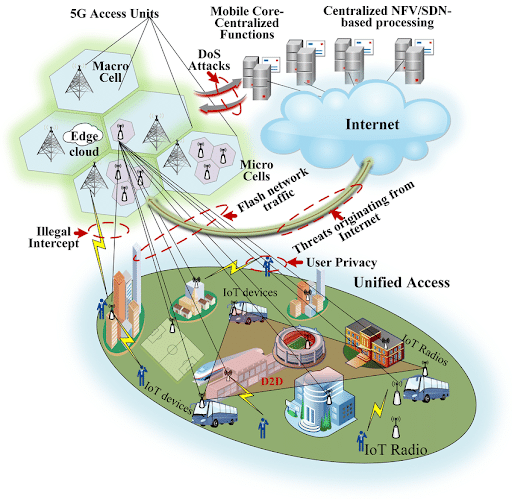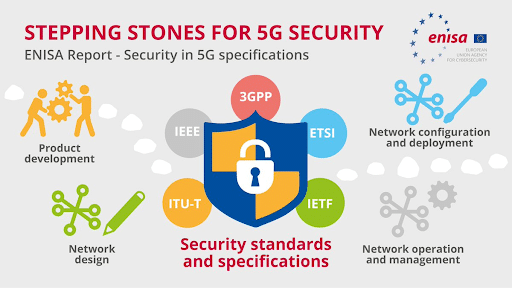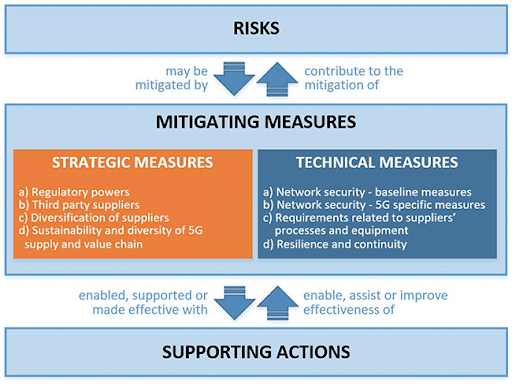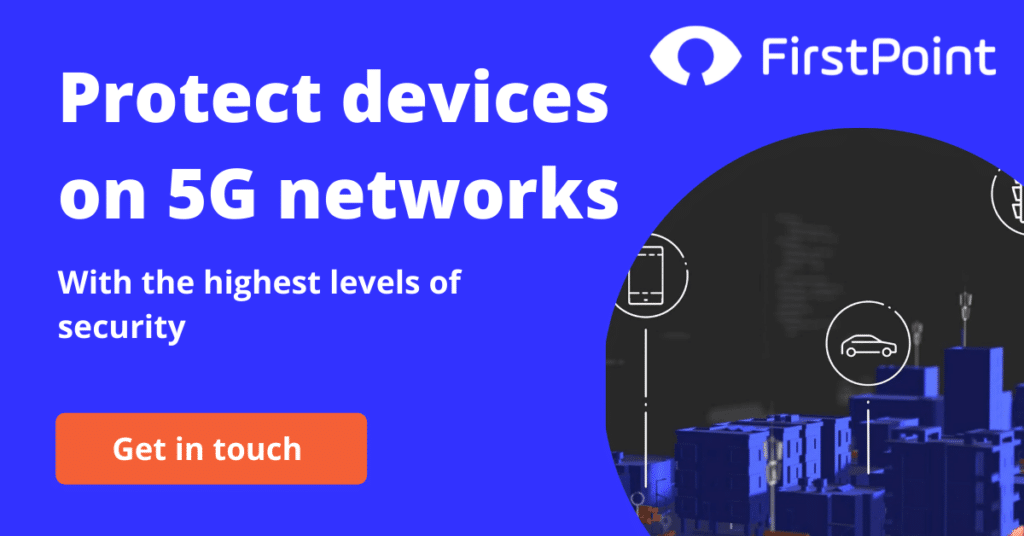The Future of 5GMobile Network Security
Billions of 5G devices are projected to go online over the next decade. The benefits of 5G connectivity are clear – higher bandwidth, wider coverage and low latency enabling advanced applications at lower costs than ever before.
In theory, 5G is also supposed to offer superior security compared to previous generations. However, the promise of safer and more reliable connectivity (compared to older mobile standards) depends greatly on the implementation of each individual 5G network. In other words – the future of 5G mobile security is, in part, up to you and how proactive you are in securing the 5G networks you deploy and manage.
To understand how to be proactive about 5G security, it’s important to first understand the current threat landscape.
What are the risks and threats to 5G networks?
5G networks face a plethora of threats. Some are inherited from older generations and legacy standards. Others are new dangers that are specific to the software-defined networking protocol introduced with 5G.

- Inherited vulnerabilities
5G by its very nature includes enhanced security measures when compared to previous mobile communication standards such as 2G, 3G, and 4G. For backward compatibility, 5G must still provide a means of communication with devices using the old standards. Without a security-minded setup to tackle the issue at its base, this interoperability requirement ensures that exploits found in the outdated SS7 and Diameter protocols used by 2G-4G networks can still plague a new 5G based network setup.
- New vulnerabilities
While 5G adoption by consumers is only just beginning, the 5G protocol itself has been available for researchers (and hackers) to study for years. During that period, at least 6 critical security flaws have been discovered, including vulnerabilities in 5G’s identification and authentication procedures.
- Man-in-the-Middle attacks
Like most IP networked equipment, 5G is susceptible to a Man-in-the-Middle attack that can intercept private data through the use of IMSI catchers and rogue base stations impersonating as legitimate mobile network operator hardware.
- IP attacks
Unlike older 2G, 3G, and 4G protocols which use proprietary hardware, 5G relies on software-defined networking (SDN) layer to do most of the heavy lifting. While SDN adds flexibility and extensibility to the 5G network, the SDN layer itself exposes 5G networks to IP (Internet Protocol) attacks such as DDoS (Distributed Denial of Service). Another form of IP attack that can be used against 5G networks is network hijacking. Network Hijacking works by rerouting sensitive information through a malicious actor’s network before the data is routed back to its intended target.
- Corrupt foreign networks
Foreign networks fall under the regulation of governments that may be more concerned with gathering information about cellular users than in consumer security. Government agencies can utilize their regulatory power to force cellular mobile network operators to install backdoors and weaken other security mechanisms without informing the public.
- Supply chain threats
Politics can impact 5G security in the form of government intervention in the production of telecommunications equipment. For example, several countries, including the UK, India, and the United States, have introduced regulations banning the use of 5G infrastructure equipment sold by Chinese vendors (ZTE, Huawei, etc.). The cause for these regulations is concern over alleged Chinese governmental influence over these 5G equipment vendors that may lead to 5G equipment sold by these vendors being compromised by design.
Are 5G mobile networks really more secure?
With improvements to the protocol and encryption algorithm in 5G, the short answer is “Yes.” The long answer is “Yes, but only if you are willing to invest in security.” There is more to securing a 5G network than just reliance on improvements in the protocol itself.
Securing a 5G network requires deploying mitigations and solutions for the known risks and vectors currently threatening 5G networks. All while dedicating resources and enforcing policies to continuously monitor and react to new threats as they emerge.
The Future of 5G Security
The evolution of cellular communication introduced with 5G requires us to familiarize ourselves with the new opportunities, threats, and trust modalities that must be considered when planning the security of future 5G networks.

Private networks, slicing & the shared security responsibility
Organizations that require the highest levels of security for national interests, economic competitiveness, or public safety will often opt for the more expensive Private 5G network. A fully private 5G network provides an organization with complete control over the network hardware and software setup. Beyond absolute control, a private 5G network sidesteps many of the vulnerabilities discussed in the threats and risks section as a private network is not required to maintain backward compatibility with older 2G/3G/4G standards.
Network slicing is a 5G feature that allows mobile network operators to create a virtual boundary for a specific customer or range of devices. Only authorized devices are allowed to connect to the sliced network, considerably limiting this attack vector. Slicing can be used as part of a private network to implement an additional layer of security or on a public network as a means of adding a security layer without the financial impact of maintaining equipment to operate the network.
When network slicing is used on public mobile networks, there is a shared security responsibility model. This is similar to cloud computing, where the network operators are in charge of securing the infrastructure, and the organization manages the software security layer.
Evolving threats
The number of 5G devices currently in development is skyrocketing. The vastly increased speed, lower latency, and device density support (devices/region) introduce new opportunities for innovative use cases for 5G technology. The explosion in the number of connected devices will quickly establish 5G as critical infrastructure for business continuity and a highly valuable target for malicious actors trying to exploit connected devices for illicit activities.
Zero Trust
Zero Trust networks function by not making any assumptions on trust. Instead of trusting specific credentials, A Zero Trust network uses multiple processes and policies to determine if a data request is valid, making it ideal for mobile operators. Designing a 5G Zero Trust network requires implementing digital identities, secure transport, a policy framework, and of course, constant monitoring.
-
Digital identities
Zero Trust networks use a unique identifier to build a digital identity trust profile. With 5G networks, this can be a SIM’s identifier, X.509 certificates, or even a specially crafted identifier unique to the network. Identities are used to manage access control by applying a custom security profile for each identity or user class/role.
-
Secure transport
To defend against eavesdropping and meta-data analysis, the 3GPP 5G standard introduced stronger encryption algorithms and the Subscription Concealed Identifier (SUCI) standard. Implementing SUCI reduces the chance of meta-data exploits that rely on the user’s identity, for example, geo-location tracking.
-
Policy framework
A policy framework controls the relationship and interaction between logical and physical entities within a 5G network. A policy framework can be used to provide fine-grained access control based on roles, credentials, and environmental factors. For example, an employee tries to access a secure resource and gets rejected because a policy framework algorithm detected the use of an insecure device or a geographically unauthorized location, even in cases where the login credentials were valid.
-
Security monitoring
Security does not comply with a “Fire & Forget” mentality. A security monitoring mechanism must be placed to evaluate whether the set policy framework is functioning as intended. By using trust-scoring using multiple factors (geo-location, OS version, etc.), whenever a request falls below the trust threshold or the trust-score trends in a downward slope, it can provide an early indication of network security issues.
5G deployment and the Internet of Things are part of a major global revolution pushing cellular technology into every aspect of our lives, from power meters to vehicle fleet tracking. As 5G becomes part of the critical infrastructure governing our daily lives, it’s important to bake security into every 5G network architecture from design through implementation and maintenance.
The post The Future of 5G</br>Mobile Network Security appeared first on FirstPoint.
*** This is a Security Bloggers Network syndicated blog from Blog – FirstPoint authored by Adam Weinberg. Read the original post at: https://www.firstpoint-mg.com/blog/the-future-of-5gmobile-network-security/





